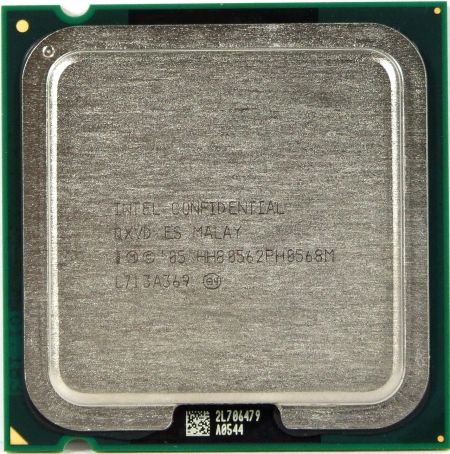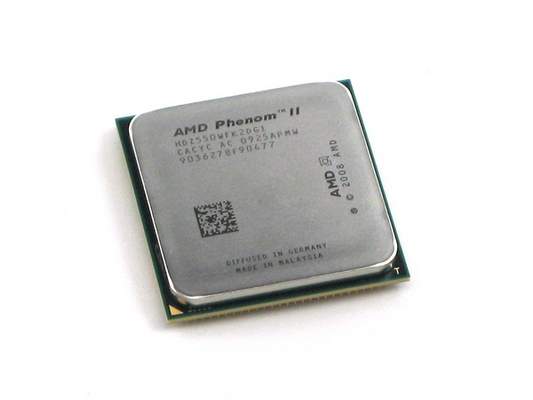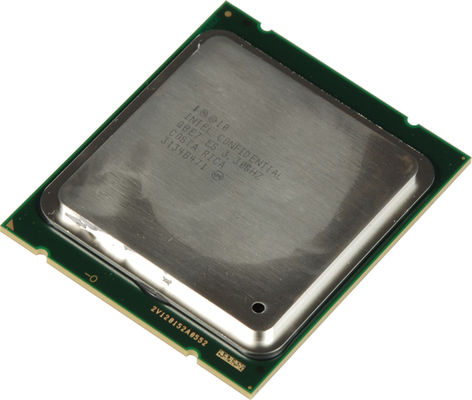14 Of The Most Legendary Overclocking-Friendly CPUs
Intel Core 2 Quad Q6600
The Core 2 Quad Q6600 was introduced in 2007. But there are still enthusiasts out there leaning on the quad-core processor even today, making this CPU somewhat of an anomaly in the fast-paced world of technological obsolescence.
Built on the revolutionary Core 2 architecture at 65 nm, and sporting a 2.4 GHz stock clock rate, the Q6600 hit the mid-3 GHz range without much trouble. That was amazing at the time, given the complexity of a quad-core processor.
Although it launched in the $850 range, the Q6600 dropped to $200 by 2010, making it popular with enthusiasts on a budget. By 2011, it was replaced by the Core 2 Quad Q9550, another CPU with a great overclocking reputation.
Intel Core i7-920
Intel's Nehalem architecture was introduced in 2008, accompanied by the Core i7 brand. Now, the Core 2 Quads weren't slouches. However, the successful re-incorporation of Hyper-Threading enabled the Core i7s to step performance up in highly parallel workloads. In addition, the LGA 1366 platform employed a triple-channel memory subsystem, with the controller built into the processor itself.
The flagship Core i7-965 Extreme (3.2 GHz) sold for $1000 and featured an unlocked clock multiplier. But the $285 Core i7-920 (2.67 GHz) offered an identical architecture for less than a third of the price. While it was multiplier-locked, the Core i7-920 achieved more than 4 GHz thanks to a forgiving BCLK. In fact, I continue using this processor in my main PC with no stability issues, a testament to the forward-looking Nehalem architecture and its X58 Express platform.
AMD Phenom II X2 550 And X3 720 Black Edition
AMD's flagship Phenom II was never an overclocking monster (effectively capping out in the 4 GHz range). But the company's Black Edition processors at least made tuning easier through access to unlocked ratio multipliers. The Phenom II X2 550 and X3 720 were extra special in that they contained disabled CPU cores that, in some cases, could be turned on using motherboards supporting this capability.
While some of these processors simply had defective cores that couldn't be resuscitated (making this a game of luck), a great many were able to operate as quad-core models, sometimes over 3 GHz. In 2010, when high-end quad-core Phenom IIs sold for $180, you could roll the dice for $100 and were often rewarded with a more premium-class chip. At worst, you had a dual- or triple-core CPU that could still be overclocked through its multiplier for relatively little.
Get Tom's Hardware's best news and in-depth reviews, straight to your inbox.
Intel Core i5-2500K
Intel introduced its Sandy Bridge-based chips in 2011, built on a 32 nm process. Compared to the top-end Core i7 CPUs, the Core i5s lacked 2 MB of shared L3 cache and Intel's Hyper-Threading feature. Neither of those nips made a huge performance difference, except in heavily-threaded workloads.
On the other hand, the Core i5-2500K included an unlocked ratio multiplier, making it possible to push the stock 3.3 GHz CPU up as high as 4.5 GHz using air cooling. We considered the $225 price tag reasonable, considering the chip's high potential performance. Even today, relatively meager gains from Ivy Bridge and Haswell make the -2500K a strong choice for mainstream enthusiasts.
Don Woligroski was a former senior hardware editor for Tom's Hardware. He has covered a wide range of PC hardware topics, including CPUs, GPUs, system building, and emerging technologies.
-
ltdementhial i had several years ago (2007?) an Pentium 2160 Oce'd all the way up to 3.4Ghz runing on an horrible "PcChips" P17g, later on moved to a C2Q q6600 and was oced to 3.6Ghz this in an Asus P45(?) (dont rememeber the model) both were cooled by an Silent Knight. before the 2160 i had an P4 Extreme Edition that was 2.8 and died on me being oc'd to 3.2 (first and only cpu i have burned ocing) i also had the 720 BE unlocked and oced to 3.8 on a 1.5vCore. (last year i posted some threads about what should i update to) and now im runing an fx 4100 oced to 4.8 cooled by a Noctua NH-D14.Reply
Maybe next year i move to what SR brings.
-
superflykicks03 Oh man I LOVED my Opteron 144 I'm glad she made the list. Could be my favorite CPU of all time. It was the best option to upgrade to a dual core on the 939 platform at the time, and I got it and a 8800 GTS 640 in order to run Crysis with decent settings. The thing I liked most aside from the generous overclocking, and what made this CPU legendary, is that as 939 dual cores became scarce, the price for these skyrocketed on online auction sites, marking the one and only time I made a Prophet on a used CPU.Reply
Pun intended. -
PreferLinux "Although it launched in the $850 range, the Q6600 dropped to $200 by 2010, making it popular with enthusiasts on a budget. By 2011, it was replaced by the Core 2 Quad Q9550, another CPU with a great overclocking reputation."Reply
I think that needs either correction or clarification. I doubt I'm the only one that read it as saying that the Q9550 released in 2011 (it was actually released in March 2008) rather than the probably intended meaning of taking over the budget overclocking CPU position. -
teh_gerbil You're missing the rare hexa core AMD 960t, 4x 3ghz.Reply
Unlockable to 6 cores, and overclockable to 4ghz! -
aggroboy Q6600 depended on if you purchased the correct stepping. I got the inferior stepping which had far less thermal headroom, forcing me to switch CPUs early when it started chugging midway through the current console generation.Reply
Just when i7-920 was feeling slightly dated, game developers started making games more multi-threaded which gave this baby a new lease of life. -
yannigr 1999 (NO idea about overclocking)Reply
Me - OK. I want that board (ΒΧ440) and I also want the Celleron 300A
Seller - With only 2000 more drachmas (6 euros) you can buy the faster 333A.
Me - I don't know, I don't want to spend more money.
Seller - It is worth it. It is faster and the difference in price small.
Me - OK put the 333A then in the order.
Almost 15 years latter I STILL HATE HIM
...lol -
ta152h The king of overclockers was the 286. Implying the internal clock multiplier somehow makes it more overclocker friendly is pretty stupid, as it's got nothing to do with anything.Reply
That was made popular by the first internal cache on x86 processors. Overclocking a chip without an internal cache had poor performance improvement. But, again, that doesn't relate to overclocking. It does relate to the fact that they were reaching a point where it was very difficult to make motherboards handle bus speeds as high as the processors (although Intel would return to that with the original Pentiums, never to return).
The 286 was a more complete overclock, since it increased the speed of everything. If you overclocked the 286 by 33%, everything ran 33% faster, even the system bus. That never happened again. Most implementations of the 386 (and even later releases of the 286) ran the AT-Bus (commonly erroneously called the ISA bus), at 8 or 10 MHz, regardless of CPU speed.
Overclocking the original PC/AT 139 was so common (from 6 Mhz to 8 Mhz), IBM put a timing loop in ROM for the 239 that prevented it. Eventually, the 339 ran at 8 MHz out of the box.
Overclocking these machines often required more skill than modern machines, as you'd have to buy a different crystal, desolder the old one, and solder the new one in. If the memory chips were close to timing, they'd have to come out too. Luckily, most were not soldered in. IBM's had a perverse piggybacked arrangement though, where they would put one 64K chip right on top of another, and they were soldered together. It looked horrible, but somehow worked like a 128Kb chip (which there never was, they went from 16K to 64K to 256K).
Leaving out the 286 is silly. It was really the first one commonly overclocked (I never hard of anyone overclocking an 8088, but someone probably did), and actually forced the largest computer company in the world to put in safeguards around it to prevent it. As strange as it sounds, my original 8 MHz Tandy 3000 showed a nice improvement going to 10 MHz. One SCSI card didn't like the faster bus, but everything else was fine. Adding in a zero wait state memory card from Cheetah also dramatically improved performance.
Even the 386 was commonly overclocked, and there were a lot of scandals because companies would buy lower clocked 386s from Intel, get rid of the silk screen, and than overclock them in the machines they would sell, without telling anyone. What a mess that was ... -
PreferLinux Reply
Hence why they started locking the multipliers...11186936 said:Even the 386 was commonly overclocked, and there were a lot of scandals because companies would buy lower clocked 386s from Intel, get rid of the silk screen, and than overclock them in the machines they would sell, without telling anyone. What a mess that was ...



